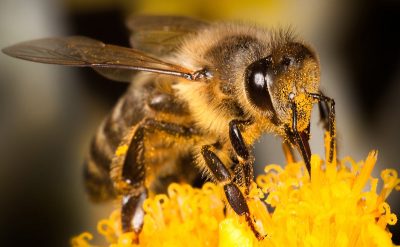Planet Pala: Bee Smart, Bee Safe

Bees – honeybees, bumblebees, and other native bees – are critical to healthy wildlands and crop production. Normally, bees in the garden are not a problem. But… large swarms can be dangerous! Even a single sting can be dangerous to someone with allergies to bee venom.

OUR NATIVE BEES
Pala has a LOT of different kinds of bees. Most people are familiar with the honeybee (Apis mellifera) and bumblebees (Bombus species), but there are dozens of other species of bees locally. Honeybees were brought from Europe for honey production and crop pollination, so are not native to the area. Most of Pala’s native bees live singly or in loose groups instead of colonies. Generally, honeybees are the most common to cause problems as they are often found around people and agriculture; used for pollination in fields and orchards; and live in large colonies. BEES DO NOT WANT TO ATTACK! Bees, even Africanized honeybees (“killer bees”) only sting if they are defending their hive or are provoked. Most stings are because a bee is stepped on, swatted, or someone is trying to remove a hive.
KEEPING BEES AWAY
Most bees are attracted to dripping water, wet areas, and sweet liquids. Fixing leaking outdoor faucets and removing standing water from kiddie pools and other backyard items can prevent large groups of bees from entering your yard (and help prevent mosquitoes as well). Covering pools and other water sources when not in use can also stop bees from coming to your water source.
Bees may be found in large swarms around recycling. Bees like nectar and other sweet liquids, including soda! Keeping recycling in covered cans, closed bags, and away from areas where children play can help prevent incidents with bees. Also, be sure to clean up spilled sweet drinks outside on warm days to stop bees – and ants – from finding it.
ATTRACTING BENEFICIAL BEES
What if you want to attract beneficial bees to your yard? Bees are useful for pollinating lots of garden flowers and food plants, and are important parts of our natural world.
Planting a wide variety of native flowers and shrubs in the yard can attract native bees. Try to plant a garden that has blooming flowers that provide nectar and pollen through all seasons, especially spring and fall. Our native bees need a variety of nesting sites, including dead plants and open, sandy soil spots.
Stop by the Pala Environmental Department for tips on SAFELY building a yard and garden for pollinators!
HELP! I HAVE A BEE PROBLEM!
If you have a bee issue, the first task is to see if there’s a reason you have a problem. Are the bees being attracted to a certain water source or heavily blooming tree? Can you remove the reason bees are showing up, or will it only be temporary – like a flower bloom? If bees, especially honeybees, are building a hive on or near your home, there can be a long-term problem.
Bees can damage structures and walls by burrowing into them and, for honeybees, through dripping honey. Honeybees will also swarm, where a bee colony splits into 2 and a female and a large group of bees move to look for a new nesting site. A swam is usually seen as a large clump of bees hanging on a tree branch or house. When swarming, bees are less aggressive but may still attack en masse if provoked.
WHAT CAN YOU DO?
Contact Us!
The PED doesn’t perform removals or pest control in homes, but we can assist with helping Tribal members find the services that will work. We can also assist with helping to design a pollinator garden, helping reduce bee conflicts in your yard, and with identifying insects around the home!
If you have a bee swarm or nest that needs removal, the easiest thing to do is to find a local bee keeper. Many will remove honeybees for no or low costs.


